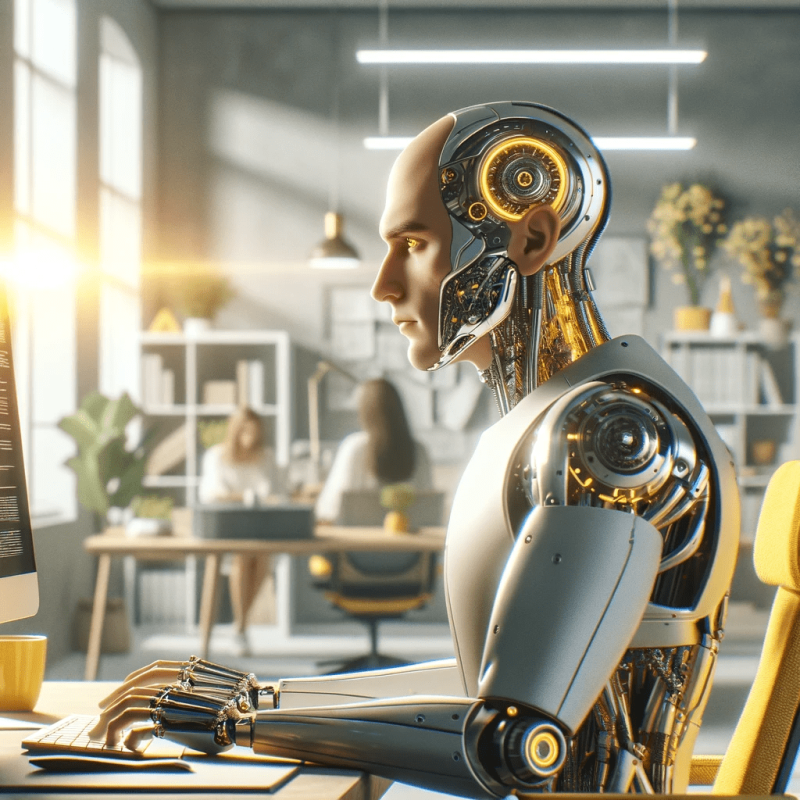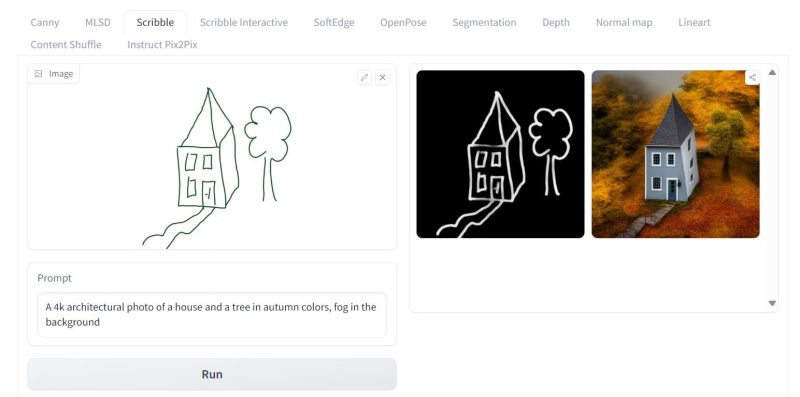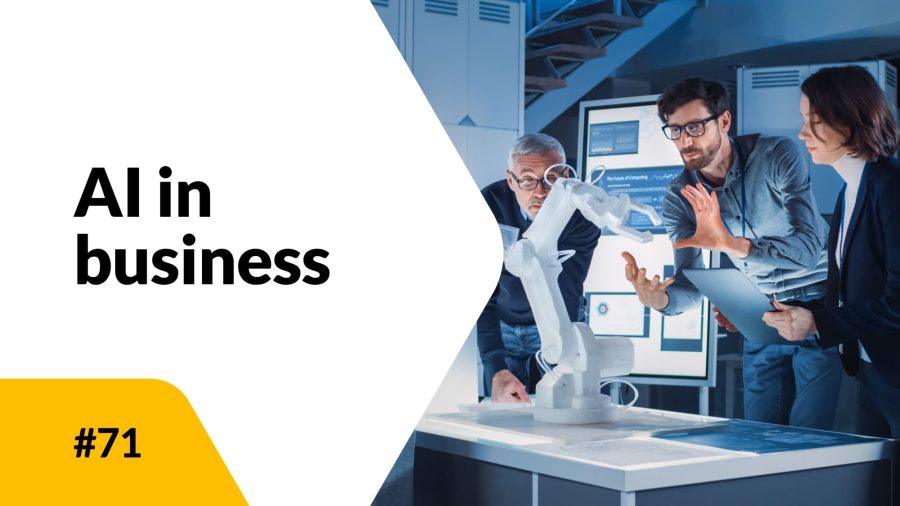How much does using AI increase the productivity of your team? - table of contents
How does AI assist professionals?
Is there any evidence that using AI during work increases productivity? Indeed! The largest study confirming this hypothesis was conducted by a group of scientists from American business schools, including Harvard Business School and MIT Sloan School of Management. Researchers examined the work of 758 consultants, representing about 7% of all consultants employed at the Boston Consulting Group.
Their task was to develop concepts for new products, taking into account aspects such as:
- creativity,
- analytical thinking, or
- persuasive skills.
As part of an experiment testing whether AI increases productivity, they compared their performance without AI support and with the use of GPT-4, the language model on which the latest version of ChatGPT Plus is based. The study aimed to examine how incorporating AI into daily work would alter the typical workflow of consultants.

Source: DALL·E 3, prompt: Marta M. Kania (https://www.linkedin.com/in/martamatyldakania/)
Does AI increase work productivity?
The results at BCG were surprisingly clear. All consultants with AI support improved the quality of their work. In fact, its quality increased up to 40%. But how was the study conducted?
In the experiment, participants were randomly divided into three groups:
- a control group — its members didn’t use AI at work,
- a group with access to GPT-4 – however, without prior instruction on how best to use artificial intelligence,
- a group with access to GPT-4 and instructional materials.
The study was divided into three phases:
- First, the consultants filled out a survey regarding their demographic data and predispositions.
- Then, they proceeded to the main part, where they performed tasks related to developing product concepts. These tasks closely resembled their daily work, involving realistic case studies, such as creating shoes for narrow target groups and athletes. The tasks required creativity, analytical thinking, as well as writing persuasive texts.
- The third phase involved interviews summarizing the consultants’ experiences with working with AI.
As it turned out, consultants using GPT-4 were 12.5% more productive and 25% faster. The greatest benefits were observed among less-skilled professionals who received additional training on effective ways to use GPT. In this group, researchers noted a remarkable 43% increase in productivity!
Ways of collaborating with artificial intelligence
Did all employees interact with AI in the same way? It appeared not. So the researchers decided to identify two most common ways in which AI increases productivity. They called them “Cyborg” and “Centaur” personas.
Cyborg
The Cyborg model represents a collaborative approach where humans and AI work closely together to achieve tasks. Examples of Cyborg collaboration include:
- a programmer starts coding, and AI complements and refines the code, just like when using Github Copilot,
- a consultant begins drawing conclusions from analysis, and AI contributes additional data and visualizations, leveraging tools like ChatGPT Plus,
- a copywriter starts crafting an advertising text from a concept, and AI suggests ideas and ready-made segments. The copywriter then refines the concept,
- an engineer sketches a project, and AI produces a visualization based on it.
In the Cyborg model, the key is the seamless integration of human and machine efforts to achieve optimal results—this is how AI significantly boosts productivity.

Source: HuggingFace (https://huggingface.co/spaces/hysts/ControlNet-v1-1)
Centaur
The Centaur model involves task delegation, where some tasks are performed by humans, and others are delegated to AI based on an individual assessment of each entity’s strengths and weaknesses. Examples of Centaur strategies include:
- AI diagnosing, and the doctor tailoring possible therapies,
- a consultant identifying a business problem, and AI generating analyses and recommendations,
- a lawyer drafting a legal complaint, and AI verifying the correctness and completeness of the document,
- a copywriter creating a text outline, and AI making stylistic and grammatical corrections.
The key is strategically dividing tasks and leveraging the strengths of both humans and machines. However, the Centaur approach presents a challenge: how to distinguish tasks better suited for AI, enhancing productivity, from those better handled by humans?
Fragmented boundaries of technology
Researchers have labeled the challenge of defining the “competence” of artificial intelligence as the “fragmented boundaries of technology.” This term pertains to the diverse and fluctuating capabilities of artificial intelligence.
The capabilities of AI are advancing rapidly, often in unexpected ways. That’s why tasks that may appear similarly challenging for humans can fall on different sides of this “boundary” – some may be easily solvable with the help of AI, while others remain beyond the current reach of its capabilities.
For example, as the study showed, GPT easily:
- generated creative ideas for new products,
- helped write persuasive copy, or
- performed detailed data analysis.
On the other hand, it made mistakes in simple mathematical calculations. This “fragmented boundary” poses a challenge for both AI designers and users – it is difficult to predict which seemingly similar tasks will be easy or difficult for algorithms. It is therefore crucial to explore and test the capabilities of AI step by step. The better we understand the “fragmented boundaries” of these capabilities, the more effectively we can integrate the work of humans and machines.

Source: DALL·E 3, prompt: Marta M. Kania (https://www.linkedin.com/in/martamatyldakania/)
How to increase productivity in your company with AI?
In your company, you can conduct a similar experiment to assess how much artificial intelligence can improve work outcomes. It’s worthwhile to start by assigning tasks to employees, such as preparing presentations, reports, business proposals, or solving case studies, both with and without the assistance of AI. This will allow you to measure the real impact on productivity and work quality.
Nevertheless, it is essential to adequately prepare employees. To observe a 40% increase in productivity with AI, similar to the success seen at Boston Consulting Group, training initiatives and the creation of instructional materials will be required.
The effort is almost certainly going to pay off. For example, advertising agencies can generate campaign ideas more quickly, banks can analyze customer data more efficiently, and legal firms can create documents more effectively. Everywhere creativity, information analysis, or text writing is needed—AI will help employees be more productive.
The future of working with AI
The development of artificial intelligence arouses both great hopes and concerns, especially among individuals who have difficulties learning new tools and adapting their work methods to the changing possibilities of technology.
There is no doubt that AI increases productivity by relieving teams from the simplest and repetitive tasks. More and more of these tasks will be automatable. New roles combining human and machine skills will also emerge, such as AI trainers or knowledge brokers. Continuous skill development and learning effective collaboration with AI will be essential.
At the same time, it is crucial to be aware of the threats. Automation may take away jobs from less skilled individuals. There is also a risk of the company becoming overly dependent on technology providers. Therefore, maintaining a healthy distance and critically assessing the information provided by AI is key.
The future of working with AI appears fascinating but also somewhat unsettling, much like in well-written science fiction. On the one hand, there are incredible possibilities, but on the other hand, do we truly have control over everything?
Summary
The results of the experiment show that AI increases productivity today. For some creative and analytical tasks, it speeds up work by up to 40%. Lower-skilled workers benefit the most, but top professionals are also faster and more efficient.
It is critical to understand which tasks can be automated by AI and which require human involvement. Changes in the way work is organized will also be needed to make the most of AI’s capabilities. And the future of work promises to be interesting – it certainly won’t be boring. If you’re curious for an even more detailed description of this study, read the full report (link).

If you like our content, join our busy bees community on Facebook, Twitter, LinkedIn, Instagram, YouTube, Pinterest, TikTok.
Author: Robert Whitney
JavaScript expert and instructor who coaches IT departments. His main goal is to up-level team productivity by teaching others how to effectively cooperate while coding.
AI in business:
- Threats and opportunities of AI in business (part 1)
- Threats and opportunities of AI in business (part 2)
- AI applications in business - overview
- AI-assisted text chatbots
- Business NLP today and tomorrow
- The role of AI in business decision-making
- Scheduling social media posts. How can AI help?
- Automated social media posts
- New services and products operating with AI
- What are the weaknesses of my business idea? A brainstorming session with ChatGPT
- Using ChatGPT in business
- Synthetic actors. Top 3 AI video generators
- 3 useful AI graphic design tools. Generative AI in business
- 3 awesome AI writers you must try out today
- Exploring the power of AI in music creation
- Navigating new business opportunities with ChatGPT-4
- AI tools for the manager
- 6 awesome ChatGTP plugins that will make your life easier
- 3 grafików AI. Generatywna sztuczna inteligencja dla biznesu
- What is the future of AI according to McKinsey Global Institute?
- Artificial intelligence in business - Introduction
- What is NLP, or natural language processing in business
- Automatic document processing
- Google Translate vs DeepL. 5 applications of machine translation for business
- The operation and business applications of voicebots
- Virtual assistant technology, or how to talk to AI?
- What is Business Intelligence?
- Will artificial intelligence replace business analysts?
- How can artificial intelligence help with BPM?
- AI and social media – what do they say about us?
- Artificial intelligence in content management
- Creative AI of today and tomorrow
- Multimodal AI and its applications in business
- New interactions. How is AI changing the way we operate devices?
- RPA and APIs in a digital company
- The future job market and upcoming professions
- AI in EdTech. 3 examples of companies that used the potential of artificial intelligence
- Artificial intelligence and the environment. 3 AI solutions to help you build a sustainable business
- AI content detectors. Are they worth it?
- ChatGPT vs Bard vs Bing. Which AI chatbot is leading the race?
- Is chatbot AI a competitor to Google search?
- Effective ChatGPT Prompts for HR and Recruitment
- Prompt engineering. What does a prompt engineer do?
- AI Mockup generator. Top 4 tools
- AI and what else? Top technology trends for business in 2024
- AI and business ethics. Why you should invest in ethical solutions
- Meta AI. What should you know about Facebook and Instagram's AI-supported features?
- AI regulation. What do you need to know as an entrepreneur?
- 5 new uses of AI in business
- AI products and projects - how are they different from others?
- AI-assisted process automation. Where to start?
- How do you match an AI solution to a business problem?
- AI as an expert on your team
- AI team vs. division of roles
- How to choose a career field in AI?
- Is it always worth it to add artificial intelligence to the product development process?
- AI in HR: How recruitment automation affects HR and team development
- 6 most interesting AI tools in 2023
- 6 biggest business mishaps caused by AI
- What is the company's AI maturity analysis?
- AI for B2B personalization
- ChatGPT use cases. 18 examples of how to improve your business with ChatGPT in 2024
- Microlearning. A quick way to get new skills
- The most interesting AI implementations in companies in 2024
- What do artificial intelligence specialists do?
- What challenges does the AI project bring?
- Top 8 AI tools for business in 2024
- AI in CRM. What does AI change in CRM tools?
- The UE AI Act. How does Europe regulate the use of artificial intelligence
- Sora. How will realistic videos from OpenAI change business?
- Top 7 AI website builders
- No-code tools and AI innovations
- How much does using AI increase the productivity of your team?
- How to use ChatGTP for market research?
- How to broaden the reach of your AI marketing campaign?
- "We are all developers". How can citizen developers help your company?
- AI in transportation and logistics
- What business pain points can AI fix?
- Artificial intelligence in the media
- AI in banking and finance. Stripe, Monzo, and Grab
- AI in the travel industry
- How AI is fostering the birth of new technologies
- The revolution of AI in social media
- AI in e-commerce. Overview of global leaders
- Top 4 AI image creation tools
- Top 5 AI tools for data analysis
- AI strategy in your company - how to build it?
- Best AI courses – 6 awesome recommendations
- Optimizing social media listening with AI tools
- IoT + AI, or how to reduce energy costs in a company
- AI in logistics. 5 best tools
- GPT Store – an overview of the most interesting GPTs for business
- LLM, GPT, RAG... What do AI acronyms mean?
- AI robots – the future or present of business?
- What is the cost of implementing AI in a company?
- How can AI help in a freelancer’s career?
- Automating work and increasing productivity. A guide to AI for freelancers
- AI for startups – best tools
- Building a website with AI
- OpenAI, Midjourney, Anthropic, Hugging Face. Who is who in the world of AI?
- Eleven Labs and what else? The most promising AI startups
- Synthetic data and its importance for the development of your business
- Top AI search engines. Where to look for AI tools?
- Video AI. The latest AI video generators
- AI for managers. How AI can make your job easier
- What’s new in Google Gemini? Everything you need to know
- AI in Poland. Companies, meetings, and conferences
- AI calendar. How to optimize your time in a company?
- AI and the future of work. How to prepare your business for change?
- AI voice cloning for business. How to create personalized voice messages with AI?
- Fact-checking and AI hallucinations
- AI in recruitment – developing recruitment materials step-by-step
- Midjourney v6. Innovations in AI image generation
- AI in SMEs. How can SMEs compete with giants using AI?
- How is AI changing influencer marketing?
- Is AI really a threat to developers? Devin and Microsoft AutoDev
- AI chatbots for e-commerce. Case studies
- Best AI chatbots for ecommerce. Platforms
- How to stay on top of what's going on in the AI world?
- Taming AI. How to take the first steps to apply AI in your business?
- Perplexity, Bing Copilot, or You.com? Comparing AI search engines
- ReALM. A groundbreaking language model from Apple?
- AI experts in Poland
- Google Genie — a generative AI model that creates fully interactive worlds from images
- Automation or augmentation? Two approaches to AI in a company
- LLMOps, or how to effectively manage language models in an organization
- AI video generation. New horizons in video content production for businesses
- Best AI transcription tools. How to transform long recordings into concise summaries?
- Sentiment analysis with AI. How does it help drive change in business?
- The role of AI in content moderation


















